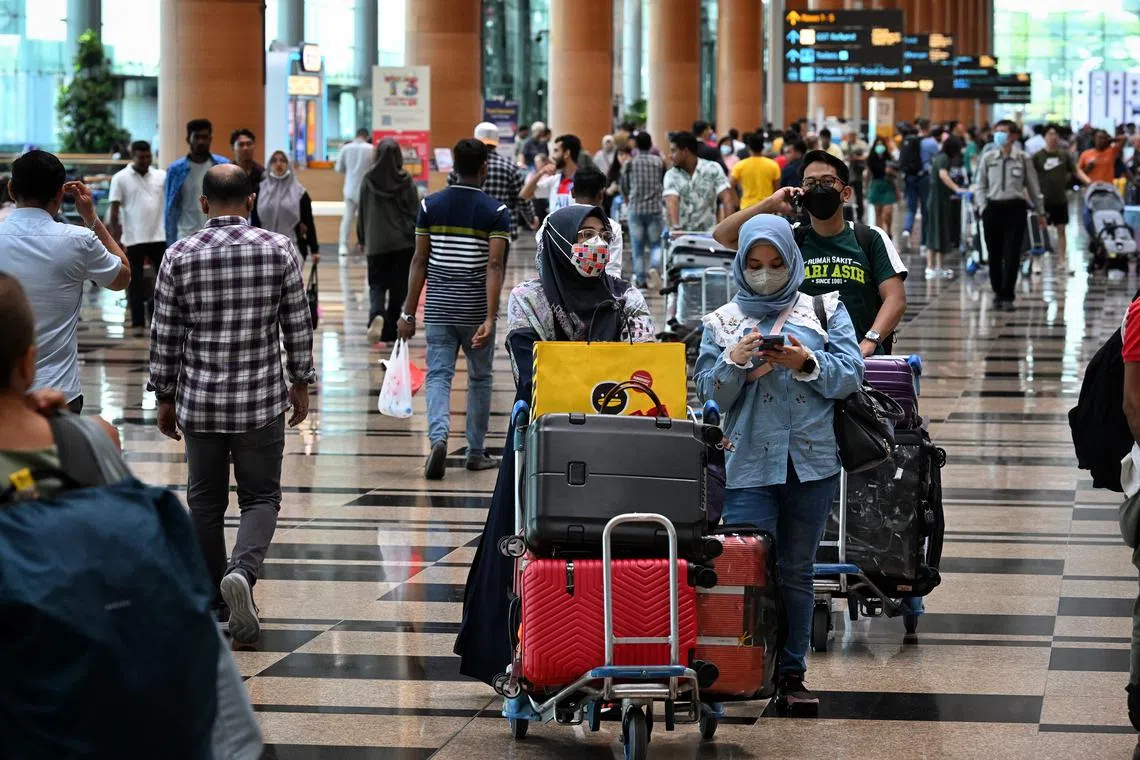Passenger traffic at Changi Airport expected to recover fully by 2024 or possibly earlier: Iswaran
Sign up now: Get ST's newsletters delivered to your inbox

The aviation sector has made a strong recovery from the debilitating impact of the pandemic, Mr Iswaran said.
ST PHOTO: CHONG JUN LIANG
Follow topic:
SINGAPORE – Passenger traffic at Changi Airport should return to pre-pandemic levels by 2024, or possibly earlier, said Transport Minister S. Iswaran.
Giving this update on Friday, he told the House that passenger traffic volumes, flights and city links at Changi are now at about 80 per cent of pre-Covid-19 levels, while flights at Seletar Airport have recovered fully since January 2023.
In 2019, a total of 68.3 million passengers passed through Changi Airport, with 382,000 commercial flights taking off or landing at the airport.
Passenger traffic fell to a low of 0.5 per cent of this total during the pandemic in 2020.
The aviation sector has made a strong recovery from the debilitating impact of the pandemic, Mr Iswaran said, noting that weekly flight services from Singapore to China
While this is a quarter of the weekly flights to China that were available in 2019, Chinese and Singapore carriers are expected to resume more services in the coming months, he added.
The aviation workforce – currently at 90 per cent of pre-pandemic levels – is also expected to recover fully by 2023, he said.
Responding to Mr Melvin Yong (Radin Mas) and Workers’ Party MP Dennis Tan (Hougang) about the upcoming Terminal 5,
The authorities are working with consultants to update the terminal’s design so that it is more modular, resilient and energy-efficient, he added.
Slated to be operational in the mid-2030s, T5 will serve 50 million passengers a year, more than T1 and T3 combined.
The Changi East development, which includes T5, support facilities and a new industrial zone, is expected to cost tens of billions of dollars.
Mr Iswaran said the Government will add another $2 billion to the Changi Airport Development Fund, which was set up in 2015 to support airport expansion projects.
It was reported in 2018 that the Government had earlier injected about $4 billion into the kitty.
Singapore’s maritime sector also performed well during the pandemic, achieving the second-highest container throughput on record of 37.3 million twenty-foot equivalent units (TEUs) in 2022, Mr Iswaran said. The unit refers to the dimensions of a standard shipping container.
Despite global economic headwinds, the mid- to long-term outlook remains positive, he added.
On the public transport front, bus and MRT ridership reached 90 per cent of pre-Covid-19 levels in January 2023, but Mr Iswaran said the recovery has been uneven.
While rail and bus trips to areas such as Woodlands and Tuas are already back to pre-pandemic levels, journeys to the downtown core during morning peak hours are at about 70 per cent of 2019 levels.
Mr Iswaran said his ministry is tracking these travel patterns, which have yet to stabilise because of adjustments to work practices.
Looking ahead, about 800 new jobs will be created as upcoming MRT lines are opened, he added.
To further equip public transport workers with skills such as data analytics and condition-based monitoring, the Government will commit a further $12 million to the Rail Manpower Development Incentive scheme.
Responding to MPs on the point-to-point transport sector (P2P), Senior Minister of State for Transport Amy Khor said the number of such trips recovered to about 80 per cent of pre-pandemic levels in 2022.
This has improved earnings for drivers, whose incomes have returned to pre-pandemic levels, she added.
However, while demand for taxi and private-hire services has increased, there are now fewer drivers, Dr Khor said.
The number of active point-to-point (P2P) drivers fell from around 69,000 before Covid-19 to 55,000 in the fourth quarter of 2022, with the number of cabbies decreasing by 9,000.
Many of those who left the industry were drivers who would drive night or weekend shifts, she said.
“With fewer P2P drivers available, riders experience high surge fares and longer waiting times, especially during the late evening or night.”
Dr Khor said private-hire operators are recruiting more new drivers, rolling out app features to better match demand and supply, and some are reintroducing ride-sharing services.
The Government, on its part, will work with operators to reduce the time to process vocational licence applications, she added, noting that the number of monthly applications has increased from about 650 in 2021 to 950 in 2022.
“We will continue working with industry stakeholders and drivers to address issues – ensuring driver livelihoods, addressing P2P availability and looking ahead to shifts in the sector’s landscape,” she said.


